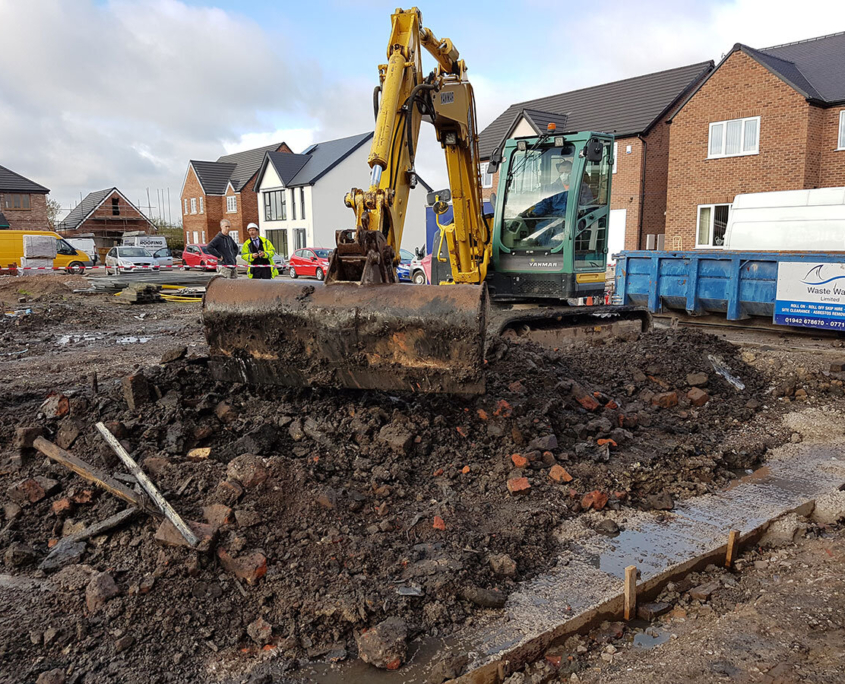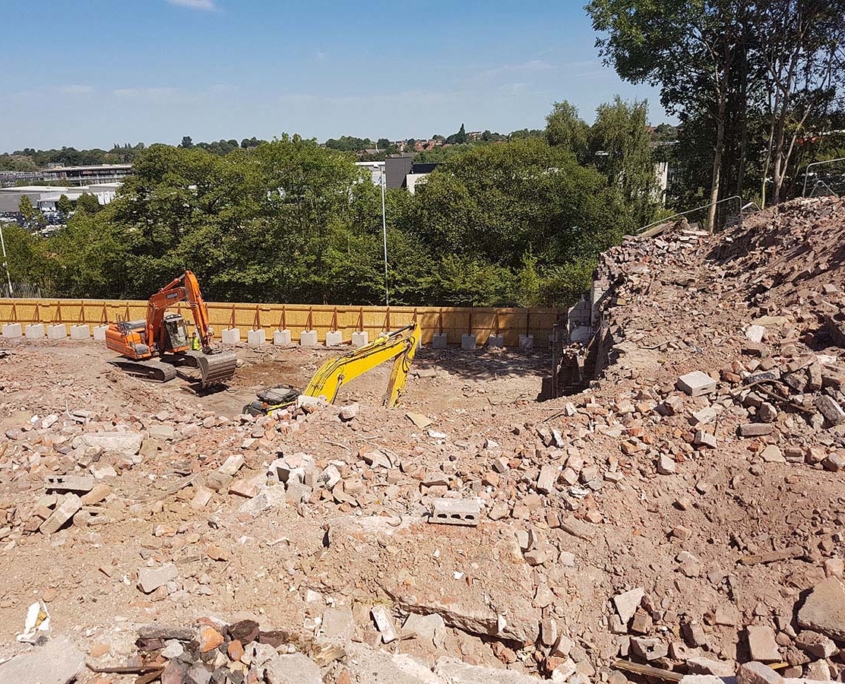Movement of Soil on Construction Sites
If you transfer Soil Waste on or Between Construction Sites, Make Sure You Are Compliant
If you move Soil Waste on or Between a Construction Site, Make Sure You Are Compliant.
Follow CLAIRE voluntary waste code of practice.
Each year news articles about illegal waste dumping and mismanagement of waste hit the headlines, but there is a voluntary waste code of practice which would have overcome the problem.
Housing firm pays £100k for dumping waste soil in Northumberland
If you are involved in construction and development being aware of and implementing the CLAIRE voluntary waste code of practice is essential to be compliant.
Make sure your company doesn’t hit the headlines for the wrong reasons.
Excavated materials on any construction site that are to be treated on or off site are generally considered waste. The person commissioning the excavation is responsible for complying with the CLAIRE Code of Practice (CoP)
What is the CL:AIRE Code of Practice (CoP) ?
The Code of Practice (CoP), was originally introduced to help organisations involved in the development of land and its remediation to increase the sustainability of their methods and approaches.
The voluntary Code of Practice (CoP) was prepared by CL:AIRE in consultation with and contributions from representatives from the development and remediation industries and the Environment Agency.
It sets out good practice for the development industry to use when:
-
- Assessing on a site specific basis whether excavated materials are classified as waste or not; and
- Determining on a site specific basis when treated excavated waste can cease to be waste for a particular use.
It describes an auditable system to demonstrate that this CoP has been adhered to.
The CoP highlights that Good Practice in the development industry when considering waste management has 3 basic steps.
- Ensuring that an adequate Materials Management Plan (MMP) is in place, covering the use of materials on a specific site;
- Ensuring that the MMP is based on an appropriate risk assessment, that underpins the Remediation Strategy or Design Statement, concluding that the objectives of preventing harm to human health and pollution of the environment will be met if materials are used in the proposed manner; and
- Ensuring that materials are actually treated and used as set out in the MMP and that this is subsequently demonstrated in a Verification Report.
At Earth Environmental and Geotechnical Ltd, we are committed to ensuring that our clients are well-informed about the various aspects of soil management and movement. Effective management of soil movement is crucial for construction, remediation, and environmental sustainability. We provide all the services you require to make sure any material excavated on your development site is reused, reclaimed, or recycled correctly.
As more brownfield sites are developed for regeneration projects and housing, the need for efficient Material Management Plans and following the CoP is now more than ever essential in providing safe and compliant development.
Contact us now to discuss your development site and how we can help manage your excavated material cost-effectively and responsibly.
Remember, the improper dumping of contaminated soil is not only detrimental to the environment but can also result in significant financial penalties.
Make Sure You Get it Right
If developers get caught HMRC can charge at full landfill tax rate. (£103.70/tonne).
Movement of Soil on Construction Sites, What You Need To Know
More Information from CLAIRE on the CoP
This CoP is directly applicable to those who commission earthworks, their appointed engineers, contractors (including specialist remediation contractors), consultants and regulatory authorities. All of these parties have a role to play if a site is being developed under this CoP. It will be of particular interest to landowners and developers.
The CoP is voluntary and applies to England and Wales only. It remains the case that demonstrating if a material is waste or not, or when it ceases to be waste, can be made without reference to this CoP on a case by case basis. It is likely, however, that an acceptable site specific demonstration will draw upon very similar lines of evidence to those detailed in this CoP.
The CoP relates to excavated material, which includes:
- Soil, both top soil and sub-soil, parent material and underlying geology;
- Soil and mineral based dredging
- Ground based infrastructure that is capable of reuse within earthworks projects, e.g. road base, concrete floors
- Made ground;
Source segregated aggregate material arising from demolition activities, such as crushed brick and concrete, to be reused on the site of production within earthworks projects or as sub-base or drainage materials; and - Stockpiled excavated materials that include the above
The following materials are outside the scope of the CoP:
- Soils which have been contaminated with injurious invasive weeds except for soils that are used on the site of production in accordance with relevant best practice guidance, e.g. Japanese Knotweed Code of Practice;
- Specific excavated infrastructure material, such as pipework and storage tanks
- General construction wastes, e.g. plasterboard, glass, wood, etc;
- Demolition wastes not included in paragraph 1.10 above
- Extractive waste within the scope of Mining Waste Directive (2006), for which alternative regulatory provisions have been made
This document applies to both uncontaminated and contaminated material from anthropogenic and natural sources excavated:
- For use on the site from which it has been excavated, either without treatment or after on-site treatment as part of the development of that land (i.e. Site of Origin scenario)
- For use directly without treatment at another development site subject to the material meeting the requirements set out in Appendix 2 (i.e. Direct Transfer scenario)
- For the use in the development of land other than the site from which the material has been excavated, following treatment at an authorised Hub site8 including a fixed
- Soil Treatment Facility (STF) acting in this capacity (i.e. Cluster Project scenario)
- Or a Combination thereof
The CoP sets out clearly what construction sites need to do when moving soil around or between construction sites and is an excellent tool to understand if any excavated material should be classified as waste.
If the requirements of this Code are complied with the material will not be waste. If the material is waste an Environmental Permit will be required to lawfully deposit or re-use it unless the material is “uncontaminated soil and other naturally occurring material excavated in the course of construction activities where it is certain that the material will be used for the purposes of construction in its natural state on the site from which it was excavated”, which is excluded from waste regulation by the Waste Framework Directive (2008)
Or if you would like your development to be compliant with all aspects of this CoP just call and we can provide all the services required, pragmatically and very cost effectively.
If you transfer Soil Waste on or Between a Construction Sites there is a CLAIRE voluntary waste code of practice that construction sites should follow.
The DoW CoP enables the direct transfer and reuse of clean naturally occurring soil materials between sites.
More About Earth Environmental & Geotechnical Ltd.
We have worked on a huge array of your sites, from former gasworks, Victorian reservoirs, sewage works, battery storage facilities, renewable energy projects, asbestos factories, electricity sub-stations, collieries, fuel retailing stations, airports, abattoirs, quarries, landfills, etc.
Our services have been used to assist in securing planning pemission and for the the planning and design of new retail stores, housing projects, renewable energy, windfarms solar projects, landfills, quarries, and the restoration of numerous brownfield sites.
We deliver, and take pride in, providing cost effective and pragmatic geotechnical and environmental solutions from our 12 offices in Bath, Cardiff, Edinburgh, Inverness, Stockport, Maidstone, Reading , Exeter, Southampton, Norwich, Birmingham and Wilton.
All of our offices are run by highly experienced Directors, backed by degree qualified staff.
Contact Us now to discuss your project
We have also completed extensive site investigation and ground investigation services in various locations throughout the UK to support new developments and construction
- trial pits
- rotary drilling
- in-situ plate bearing
- Cable Percussive Boreholes
- Window Sample Drilling
- Deep Window Sample Borehole
- Rock Coring
- Rotary Boreholes
- Rotary Core Drilling
- Dynamic Probing
- Trial Pits
- Trenches
- Windowless Sampling Rig
- Soakaway Testing
- Modular windowless sampling drilling rig
- Infiltration tests
- Ground penetrating radar
- Soil Sampling
- Earthwork Modelling
- Contaminated Land Assessments
- Material Management Plans








